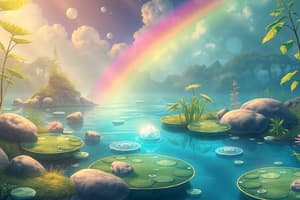Podcast
Questions and Answers
What is the initial source of energy in most biological communities?
What is the initial source of energy in most biological communities?
- Water
- Sunlight (correct)
- Soil
- Wind
What is the process through which producers convert light energy to chemical energy?
What is the process through which producers convert light energy to chemical energy?
Photosynthesis
Consumers obtain their energy from sunlight.
Consumers obtain their energy from sunlight.
False (B)
What is the term for organisms that produce their own food?
What is the term for organisms that produce their own food?
How many trophic levels do food chains commonly contain?
How many trophic levels do food chains commonly contain?
What happens to the energy transformed by living organisms during respiration?
What happens to the energy transformed by living organisms during respiration?
Living organisms can convert heat energy to other forms of energy.
Living organisms can convert heat energy to other forms of energy.
What indicates the direction of energy flow in a food chain?
What indicates the direction of energy flow in a food chain?
What is the position of an organism within a food chain called?
What is the position of an organism within a food chain called?
Only about 50% of energy is passed from one trophic level to the next.
Only about 50% of energy is passed from one trophic level to the next.
Energy released from carbon compounds by __________ is used in living organisms.
Energy released from carbon compounds by __________ is used in living organisms.
What is one of the causes of energy loss in ecosystems?
What is one of the causes of energy loss in ecosystems?
What term describes the energy transfer that occurs when one organism consumes another?
What term describes the energy transfer that occurs when one organism consumes another?
Which group of organisms feeds on decaying organic matter?
Which group of organisms feeds on decaying organic matter?
Heat produced in living organisms is retained within the ecosystem.
Heat produced in living organisms is retained within the ecosystem.
Flashcards are hidden until you start studying
Study Notes
Energy in Ecosystems
- Ecosystems generally depend on sunlight as the primary energy source.
- Producers (plants, algae, cyanobacteria) utilize photosynthesis, while consumers, detritivores, and saprotrophs are heterotrophs that derive energy from food.
Photosynthesis
- Light energy> chemical energy transformation occurs during photosynthesis:
CO2 + H2O + light energy → C6H12O6 + O2. - Producers convert sunlight into chemical energy, which helps synthesize carbohydrates, lipids, and other carbon compounds.
Roles in Energy Supply
- Producers absorb light and convert it to chemical energy; they form the foundation of the food chain.
- Consumers, detritivores, and saprotrophs obtain energy via the consumption of producers or other organisms.
- Food chains start with producers that convert sunlight into carbon compounds through photosynthesis.
Energy Flow in Food Chains
- Food chains illustrate the linear transfer of energy where each organism feeds on the preceding one.
- Arrow notation indicates energy direction, with two to five organisms typically represented in a chain.
- Energy and biomass transfer is generally limited to about 10% from one trophic level to the next.
Trophic Levels
- Organisms are classified into trophic levels: producers (1st level), primary consumers (2nd level), secondary consumers (3rd level), and tertiary consumers (4th level).
- Food chains commonly contain three or four levels, rarely exceeding five.
- Energy loss at each level explains the restricted length of food chains and the biomass of higher levels.
Energy Utilization and Loss
- Chemical energy in carbon compounds is released via respiration, which is vital for ATP production.
- Cellular activities such as synthesizing macromolecules, active transport, and internal movement require ATP.
- Approximately 80%-90% of the energy in carbon compounds is lost as heat during these transformations.
Inefficiency of Energy Transfer
- Living organisms cannot convert heat energy back into usable forms; they can only convert light and chemical energy into other forms.
- Energy flow in ecosystems does not allow complete transfer; heat is consistently lost to the environment.
Heat Loss and Ecosystem Balance
- Heat generated by living organisms dissipates into the abiotic environment, ultimately affecting the ecosystem's energy balance.
- Ecosystems rely on an external energy source (primarily sunlight) to compensate for ongoing energy losses.
Energy in Food Chain Transfers
- Energy transfer to detritivores or saprotrophs occurs when:
- Organisms die before being consumed.
- Portions of organisms remain uneaten (bones, fur).
- Indigestible parts (cellulose) are excreted as waste.
Energy Pyramid Overview
- Energy pyramids represent energy distribution among trophic levels, highlighting the inefficiency and loss of energy as it moves through the food chain.
Studying That Suits You
Use AI to generate personalized quizzes and flashcards to suit your learning preferences.




